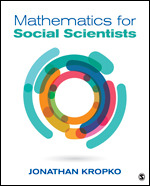Mathematics for Social Scientists
- Jonathan Kropko - University of Virginia, USA
Quantitative/Statistical Research (General)
Available with Perusall—an eBook that makes it easier to prepare for class
Perusall is an award-winning eBook platform featuring social annotation tools that allow students and instructors to collaboratively mark up and discuss their SAGE textbook. Backed by research and supported by technological innovations developed at Harvard University, this process of learning through collaborative annotation keeps your students engaged and makes teaching easier and more effective. Learn more.
Supplements
Use the Student Study Site to get the most out of your course!
The companion website includes solutions to the practice problems in the book.
“Students in the social and behavioral sciences increasingly need a solid foundation of mathematical knowledge to be able to contribute to the research literature and be able to keep themselves current on new methodology. Unfortunately, math department classes really are not tailored to their needs. Mathematics for Social Scientists, on the other hand, is clearly aimed at what students need to be able to advance in subsequent methodology courses and in their future careers. It is written in an inviting and clear manner, without ever sacrificing rigor.”
“Many students entering higher-level statistics classes have somehow forgotten their basic statistics or were never properly exposed to more than a cookbook explanation. More often than not, a student will leave the course without an understanding of probability, random variables, basic distribution theory and concepts etc. Without some background, it proves difficult for students to catch up with these ideas when they are introduced (or assumed to be known) in more advanced courses. This gap is especially pronounced between those students who were exposed to basic probability in a previous course and those who were not. Mathematics for Social Scientists will be a great resource for an instructor wishing to add this content to a basic statistics course as well as for the motivated self-learner.”
This is a required texbook for understanding advanced univariate and multivariate statistics. I use this book as complementary book in my courses.

